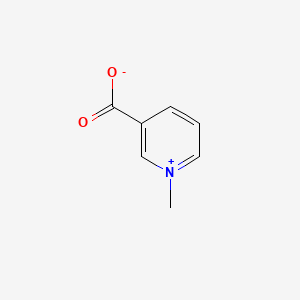trigonelline, trigonelline chloride, trigonelline iodide, trigonelline ion, trigonelline tosylate



| Name | Trigonelline | ||
| PubChem CID | 5570 | ||
| Molecular Weight | 137.14g/mol | ||
| Synonyms |
trigonelline, trigonelline chloride, trigonelline iodide, trigonelline ion, trigonelline tosylate |
||
| Formula | C₇H₇NO₂ | ||
| SMILES | C[N+]1=CC=CC(=C1)C(=O)[O-] | ||
| InChI | 1S/C7H7NO2/c1-8-4-2-3-6(5-8)7(9)10/h2-5H,1H3 | ||
| InChIKey | WWNNZCOKKKDOPX-UHFFFAOYSA-N | ||
| CAS Number | 535-83-1 | ||
| ChEMBL ID | CHEMBL350675 | ||
| ChEBI ID | CHEBI:18123 | ||
| Herb ID | HBIN047060 | ||
| KEGG ID | C01004 | ||
| Toxicity | Organism | Test Type | Route(Dose) |
| rat | LD50 | intraperitoneal(165 mg/kg) | |
| mouse | LD50 | intraperitoneal(254 mg/kg) | |
| rat | LD50 | oral(322 mg/kg) | |
| Structure | 
|
Download
2D
MOL
3D
MOL
|
|
| Chineses Pinyin | HuLuBa | ||
| Use Part | Seed | ||
| Habitat | AnHui, SiChuan, HeNan | ||
| Species |
>Kingdom: Viridiplantae
-->Phylum: Streptophyta
-->Class: Equisetopsida
-->Order: Fabales
-->Family: Fabaceae
-->Genus: Trigonella
-->Species: Trigonella foenum-graecum
|
||
| Pair Name | Trigonelline, Cisplatin | |||
| Partner Name | Cisplatin | |||
| Disease Info | [ICD-11: 2C25.Z] | Lung cancer | Investigative | |
| Biological Phenomena | Induction-->Apoptosis | |||
| Gene Regulation | Down-regulation | Phosphorylation | NFE2L2 | hsa4780 |
| Down-regulation | Expression | NQO1 | hsa1728 | |
| Down-regulation | Expression | HMOX1 | hsa3162 | |
| Down-regulation | Phosphorylation | EGFR | hsa1956 | |
| Down-regulation | Phosphorylation | MAPK1 | hsa5594 | |
| Up-regulation | Cleavage | PARP1 | hsa142 | |
| Up-regulation | Cleavage | CASP3 | hsa836 | |
| Up-regulation | Expression | BAX | hsa581 | |
| Down-regulation | Expression | BCL2 | hsa596 | |
| In Vitro Model | A-549 | Lung adenocarcinoma | Homo sapiens (Human) | CVCL_0023 |
| NCI-H460 | Lung large cell carcinoma | Homo sapiens (Human) | CVCL_0459 | |
| NCI-H1299 | Lung large cell carcinoma | Homo sapiens (Human) | CVCL_0060 | |
| Result | Our study demonstrated that Trigonelline blocks Nrf2 activation and its nuclear translocation via inhibition of EGFR signalling pathway. It has improved responsiveness of NSCLC cells for Cisplatin and Etoposide and could be a promising choice for lung cancer therapy. Toxicol In Vitro. 2021 Feb;70:105038. doi: 10.1016/j.tiv.2020.105038. | |||
